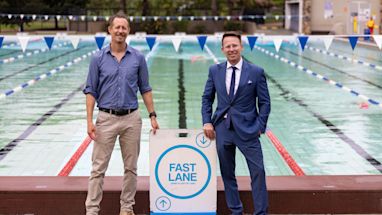For decades the Goldsbrough Mort building has dominated the skyline over Pyrmont and Darling Harbour.
It was the centre of Sydney’s wool trade with its immense floor space storing goods for export – but now it’s forging a new, more sustainable history.
As one of the original buildings to sign up to our smart green apartment program, it’s just been recognised for its work cutting energy and maintenance costs. Could your building do the same?

An evolution from enabling trade, to generating clean energy
The Goldsbrough building is no stranger to big changes.
Originally built in 1883, it burned to the ground in 1935 with the rebuilt warehouse converted into 500 apartments in 1995.

For over a century it was Sydney’s centre for the wool trade. But in the past decade it has been a shining example for embracing the opportunities presented by transitioning to clean energy.
Sydney MP Alex Greenwich recognised the “cutting-edge sustainability work” with a community recognition statement made to the NSW parliament acknowledging “efforts to plan for the future, reduce emissions, and help improve liveability in the Sydney electorate.”

“The Goldsbrough Mort is a shining example of how the City of Sydney is supporting apartment buildings to reduce their running costs while doing their bit to make Sydney a more sustainable city”, Lord Mayor of Sydney, Clover Moore AO said.
“We’ve already helped hundreds of buildings reduce emissions and water use and I’m eager to see even more sign up and make positive change.”
Bringing benefits to its residents through considered change
The Goldsbrough building is an original member of the smart green apartments program, signing up in 2011.
It had already taken the first steps on its sustainable journey when it received funding from the City of Sydney to establish an emissions baseline and identify areas to cut costs and reduce reliance on fossil fuels.

Goldsbrough facilities manager Gary Binskin said one of the main goals was to install a solar array on the rooftop.
“By attending shows and conferences at the International Convention Centre and bringing exhibitors to the building, this allowed me to develop ideas and glean information to strategise what was best suited to Goldsbrough,” Binskin said.
That solar array includes 391 panels with a 176kW capacity. But smart green apartments helps guide much more than solar on rooftops.
In the past 10 years, the building has completed several efficiency and renewable energy projects. These include:
- swapping inefficient lights with LEDs in all common areas, including the use of timers and sensors
- installing variable speed drives on pumps and in upgraded lifts
- recovering heat from hot water and redirecting it to the pool and spa
- replacing electric boilers at end-of-life with new efficient heat pumps
- capturing condensation from the cooling tower to be reused (reducing water top-ups resulting from evaporation by 40%).
Energy costs have dropped by around 40% thanks to its investment in solar energy and efficient heat pumps which replaced old electric boilers.
The building is now considering storing solar electricity in batteries to use when demand for electricity is high or when grid prices are expensive. It’s also investigating opportunities for vertical wind technology.

How can others get involved in the smart green apartments program?
The City of Sydney’s program has helped more than 200 buildings with advice on ways to reduce energy and water use in apartment buildings.
The program helps establish a baseline and provides a guide on the best ways to go about reducing running and maintenance costs through efficiencies. Importantly, the program provides advice only and doesn’t include the capital to implement the recommendations.
We welcome a yearly intake for buildings that meet certain criteria, such as a minimum of 70 residential apartments.
Published 11 October 2023, updated 12 October 2023



